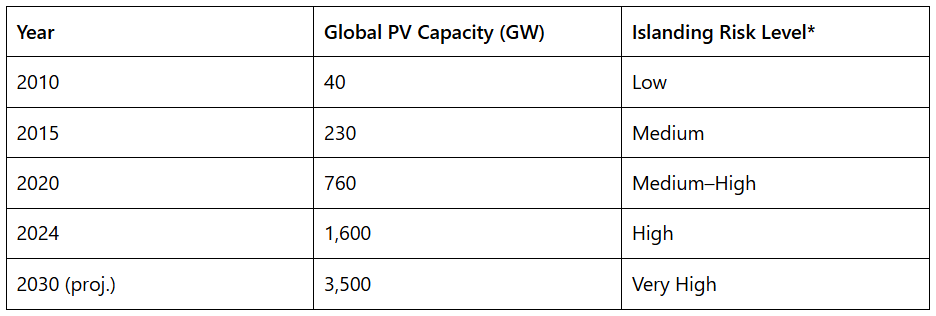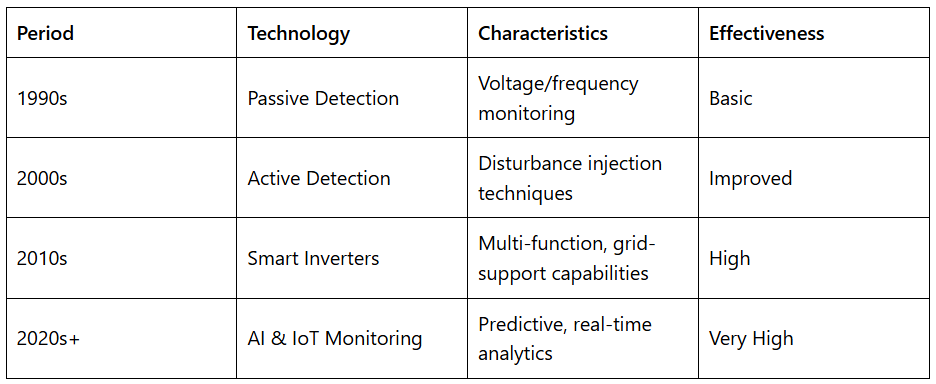
Introduction: Why Islanding Is the Silent Threat in Solar Power
Solar PV is rapidly becoming the world's leading renewable energy source, projected to surpass 2,000 GW of global capacity by 2025. Yet behind this success lies a hidden risk: islanding—the condition where a PV system keeps generating power even after the grid shuts down. Far from harmless, islanding can disrupt grid stability, endanger utility crews, and damage equipment. As solar integration accelerates, anti-islanding protection has become essential for EPCs, developers, and utilities to ensure safe and reliable deployment.
What is Islanding in Solar PV Systems?
To understand the urgency, we need to break down what islanding means.
- Unintentional islanding: This occurs when a PV system continues to operate without grid support during outages. It is the most dangerous type because it is unexpected and uncontrolled.
- Intentional islanding: In contrast, microgrids or backup systems sometimes deliberately operate in “island mode” to provide localized power. These cases are engineered and managed.
The first type is the real risk. If a utility worker believes a line is de-energized during maintenance but a rooftop solar system is still feeding electricity, the result could be fatal. Moreover, unintentional islanding can cause voltage and frequency mismatches, leading to equipment breakdown and cascading failures across the grid.
Why Islanding Protection Is Essential for Grid Stability
The global grid is built for synchronization. Any unscheduled injection of power creates instability. Islanding disrupts that delicate balance.
- Worker safety: Live wires during maintenance pose shock hazards.
- System reliability: Unsynchronized power flows can destabilize the grid.
- Equipment integrity: Sensitive inverters and transformers may overheat or fail.
- Regulatory adherence: Compliance with anti-islanding standards is required for grid connection.
Chart 1: Consequences of Islanding on Grid Operations

This shows that while all risks are serious, safety and compliance remain the most urgent concerns.
How Anti-Islanding Works: From Basic to Advanced Solutions
The solar industry has developed sophisticated techniques to counteract islanding. The most widely used methods fall into two categories:
Passive Detection
- Relies on monitoring grid voltage, frequency, and current.
- If abnormal fluctuations occur, the system assumes disconnection.
- Pros: Simple and inexpensive.
- Cons: May fail in cases of balanced load and generation.
Active Detection
- Introduces small disturbances (frequency shifts, phase variations) to confirm grid status.
- More reliable at detecting subtle disconnections.
- Cons: Slight efficiency loss during operation.
Modern smart inverters combine both methods, ensuring compliance with IEEE 1547, UL 1741, and IEC 62116 standards. These inverters don't just shut down during faults—they also provide grid-support functionalities like voltage regulation and reactive power compensation.
Solar Growth and the Rising Challenge of Islanding
The challenge of islanding is amplified by the sheer pace of solar adoption.
- In 2010, global solar capacity was around 40 GW.
- By 2024, it had surpassed 1,600 GW.
- Projections for 2030 suggest over 3,500 GW installed worldwide.
With this exponential growth, distributed PV is no longer a marginal contributor—it is a central pillar of the grid. This makes anti-islanding protection more critical than ever.
Chart 2: Global Solar PV Capacity Growth vs. Islanding Risk

*Risk level represents the likelihood of islanding events affecting grid stability as distributed solar penetration rises.
Best Practices for EPCs and Solar Developers
For EPC contractors and solar developers, implementing effective anti-islanding protection translates directly into project success and investor confidence. Key practices include:
- Select compliant inverters certified under IEEE 1547, UL 1741, or IEC 62116.
- Conduct commissioning tests to verify shutdown times. Most standards require disconnection within 2 seconds of grid loss.
- Collaborate with utilities to align with local interconnection requirements.
- Deploy real-time monitoring systems that track grid interaction.
- Educate customers about the importance of islanding protection to strengthen trust and transparency.
In an increasingly competitive market, these practices not only reduce risk but also help companies secure faster grid approvals and stronger customer relationships.
Smart Grids and the Future of Islanding Protection
As energy systems evolve into smarter, more digital networks, anti-islanding is becoming more sophisticated.
- Grid-forming inverters are enabling PV systems to support microgrids without compromising safety.
- Artificial Intelligence (AI) and IoT-enabled monitoring allow real-time detection of abnormalities.
- Energy storage integration ensures controlled islanding in intentional microgrids, without creating safety hazards.
Chart 3: Evolution of Islanding Protection Technologies

This progression illustrates how the industry has steadily moved toward more intelligent and reliable islanding protection solutions.
The Business Case: Why Anti-Islanding Protection Adds Value
For solar companies, anti-islanding protection is not just about compliance—it is a strategic differentiator.
- Faster project approvals: Certified systems move through utility interconnection more smoothly.
- Reduced liability: Protects against legal risks tied to worker accidents or grid damage
- Investor confidence: Demonstrates technical robustness, which reassures stakeholders.
- Reputation building: Companies known for safety and compliance gain stronger market credibility.
As global competition intensifies, EPCs and solar solution providers that prioritize islanding protection will stand out as leaders in reliability and innovation.
Future Outlook: Toward a Safer Solar Grid
Looking ahead, the solar industry will see:
- Greater reliance on hybrid systems combining PV, storage, and smart inverters.
- Regulatory harmonization across regions, making global compliance easier.
- AI-driven predictive analytics to detect early signs of islanding before it occurs.
- Stronger utility-solar collaboration, where distributed energy resources become active partners in grid stability.
The direction is clear: solar power must not only grow—it must grow safely, with islanding protection at its foundation.
Conclusion: Sunpal's Commitment to Grid-Safe Solar Power
Islanding protection is no longer just a technical requirement—it is a foundation for safe, reliable, and scalable solar PV deployment worldwide. By aligning with global standards and adopting advanced detection and prevention technologies, the solar industry can ensure secure grid integration while supporting the transition to clean energy. To explore how Sunpal Solar delivers compliant, future-ready PV solutions, visit us at www.sunpalsolar.com.
